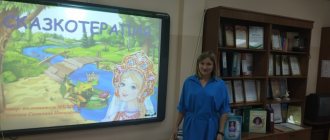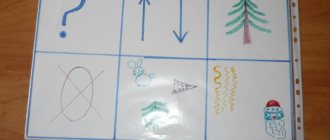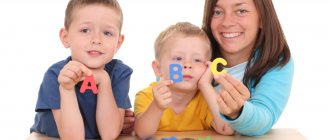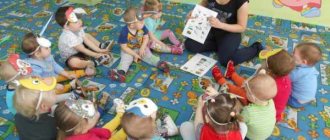Center for Speech Development according to Federal State Educational Standards
The speech development center involves conducting classes individually and in subgroups of 2-3 students. It also becomes one of the centers of children’s independent activity; they are pleased and interested in studying visual materials and playing here.
The goal of creating a center for speech development is the optimal organization of a developmental environment for improving the speech abilities of students.
The tasks of the speech development center directly depend on the age and individual characteristics of the children.
| Children's age | Tasks | |
| 1.5–3 years |
|
|
| 3–4 years |
| |
| 4–5 years |
| |
| 5–6 years |
| |
| 6–7 years |
|
Design of the speech development center
The speech development center is equipped and staffed in accordance with the age of the pupils. Thus, every year it is transformed and enriched to make it interesting and productive for children to study here.
For younger preschoolers, the speech development corner may include a sensory area - a place for the development of fine motor skills. As an option, this is a table with educational games: pyramids, a sorter, books and toys with buttons, bags of seeds and pebbles.
This could be a rug on the wall with buzzers, rubber bands, a plastic mirror, buttons, felt pictures, ribbons, and Velcro. The sensory mat usually depicts the plot of a fairy tale familiar to children (“Turnip”, “Teremok”, “The Three Little Pigs”) or images of natural objects, animals: flowers, trees, butterflies, birds, bunnies, etc. Everyone knows that a child’s first he actually wants to touch the object that interests him, so a developmental rug is made from pieces of bright fabric, scraps of velvet, printed ribbon, and colorful braid.
For all age groups of preschoolers, objects and play sets for the development of speech breathing should be presented in the corner. For these purposes, waste material and simple toys are used: plastic tubes and cups, ping-pong balls, cotton balls, plumes and pinwheels, flags, balloons. The teacher includes breathing exercises in play activities.
In the speech corner of the senior and preparatory groups, a place is set up for board and printed games. The selection is made up of games with letters and words:
- “Entertaining ABC”: for cards with letters (uppercase and printed), you need to select cards with images of objects for these letters. “ABC Lotto”: cards with beeches are filled with chips with animals whose names begin with these letters. “Kaleidoscope of Letters”: children learn to recognize the symbolic designations of letters on the playing field. “Make a word. Dominoes: cards are used to create an image and its name. “Who lives where”: cards with words, animals and their habitats.
To stimulate children's verbal creativity and play dramatization games, a small area with a screen, decorations, and dolls is set up in the corner. Unlike the theatrical activity corner, the space for performances in the speech corner is limited. For example, you can cover a cardboard box - it will be a fairy-tale forest for the figurines. Dialogue using hand puppets and bibabo can be acted out from behind a folding paper screen.
Requirements for the speech development corner according to the Federal State Educational Standard for Preschool Education
Optimal location: the corner is sufficiently lit, located in a quiet place next to the book, theater and sensory development corners.
Compliance with the age and individual needs of children. The presence of an animated character - a doll or toy. The character who owns the corner encourages children to engage in speech activity: he tells funny stories, invites them to play, and asks questions. With the help of an animated toy, motor exercises and articulatory gymnastics are demonstrated. Aesthetics. The corner is designed in the same style as the areas for artistic reading and theatrical activities. The place of study attracts not only with bright colors, but also with interesting objects: reproductions on the wall, figurines on the shelf. Didactic and gaming materials are located in a corner by topic, and students learn to maintain order. Safety. Pupils of the first and second junior groups independently practice the development of fine motor skills under the supervision of a teacher (due to the danger of small parts getting into the respiratory tract). It is not recommended to equip the speech corner with hanging shelves or cabinets with glass doors. Electrical appliances and power supplies must be out of the reach of children. Names of the speech development center
The name of the developmental activity corner in kindergarten should be short and understandable. Traditionally, the activity center is named after the actual focus of the activity. Since a mandatory attribute of a speech corner is an animated toy, the name of this fantasy character is often used in the name. Unusual and funny names arouse additional interest among students. You can arrange a competition for children and parents to come up with a name.
- Classic names: “Speech Corner”, “Speech Coach”, “Speech Development Corner”, “Learning to Talk”, “Speech Development Lessons”.
Titles with the name of the owner of the corner: “Lessons of Aunt Owl”, “Hello, Dunno!”, “Visiting Luntik”, “Button Invites”, “Talker”, “Mushka the Talker”, “Bunny the Lopotushka”.
Funny names: “Let's Talk”, “Gazebo”, “Zvukarik”, “Govoryashka/Govorusha”, “Azbukvarik”, “ABVGDEyka”, “Govorilki”, “Logostrana”, “Let’s Sit and Talk”, “Rechetsvetik”.
Contents of the speech development center
A special place in the speech corner is given to the animated character. The kids talk with this toy or picture in a playful way, he “sends” them parcels with new games and letters with tasks.
For the children's activity center, environmentally friendly (plastic, wooden, upholstered) furniture is selected. Cabinets, chairs and tables should be comfortable and suitable for the height of children. Sample list of furniture for a speech corner:
- Wardrobe/rack with shelves. Table or shelf for temporary exhibitions. Desk and chairs.
Equipment in the speech development corner:
Mirror. To perform articulation exercises, the child needs to monitor his facial expressions, learn to independently control and direct his actions. The mirror should be securely mounted on the wall and located at the work desk, firstly, it is convenient for the child during class, and secondly, this eliminates the risk that children will accidentally touch the mirror and it will fall.
Audio recorder, TV. One of the components of speech development in kindergarten is enriching the auditory experience of pupils. Children hear literate speech, correct pronunciation, and logically constructed statements—their culture of oral communication is formed. For this purpose, audio tales and recordings of artists reading poems are listened to in the speech corner. Watching short videos serves as material for building further conversation.
Magnetic board. As mentioned above, such a board can be used to post current information, display photographs and illustrations on the topic of the lesson. But more often it is used for students to perform exercises. For example, in the following tasks: “Arrange the pictures in the correct sequence to form the plot of a fairy tale. Try to retell it,” “Make words from the letters of the magnetic alphabet...”, “Distribute the pictures by topic, come up with a name for each of them.”
Composition of the material base of the speech development corner
| Visual materials, manuals |
|
| Materials for sensory development |
|
| Items for breathing development |
|
| Didactic materials |
|
| Materials for dramatization games |
|
Speech activity center in the senior group
Natalya Tukmacheva
Speech activity center in the senior group
*Tasks:
Carry out work on the development of children’s speech according to comprehensive thematic planning
Ensuring the possibility of independent individual speech activity of the child;
Ensuring the child’s comfortable state in the manifestation of speech reactions ;
Providing opportunities for exploration and experimentation within the language system.
Providing the opportunity to perceive and observe the correct speech of children;
* The purpose of building a speech development environment :
Saturation of the environment with components that ensure the development of speech in a preschool child
providing assistance in mastering the content of the main general education program of a preschool educational institution through the interaction of the teacher and the child, parents.
* Relevance of building a speech development environment :
Based on the Federal State Educational Standard for Education, we want to see our children: physically developed, inquisitive, active , emotionally responsive, mastered the means of communication, able to manage their behavior, capable of solving intellectual and personal tasks (problems)
age appropriate.
* Modern children experience difficulties in mastering the means of communication, because television, computers, and short conversations on the phone replace friendly communication with adults and peers. Adults, trying to increase the pace of their lives, began to pay less attention to children
* Center for Speech Development thematically:
To develop the lexical and grammatical side of speech, folders with subject and plot pictures for retellings, word games and tasks on the current lexical topic were purchased. This contributes to the development of speech, expansion of ideas about the world around us, spatial orientation, observation and imagination
Together with teachers, we decided to enrich the subject-development environment, namely, to create a speech center .
The content of the center was not determined by chance, but in strict accordance with the program, physiological and psychological-pedagogical features of the formation of children's speech.
* To correct sound pronunciation, there are picture material for articulation gymnastics, mirrors for individual work, workbooks with articulation exercises and corresponding entertaining picture material, albums with fairy tales for articulation gymnastics, albums with pure words for whistling, hissing and sonorant sounds, for differentiation of sounds
* To prepare for learning to read and write, a center has been designed with a magnetic board , a magnetic alphabet and a set of colored magnets. There are also supporting diagrams for composing stories, the center is equipped with factory-made d/i, and it also contains hand-made games: “Mine, mine, mine, mine”
,
“Settled in houses”
,
“Merry caterpillar”
,
“Syllabic clock”
, etc.
* Didactic game “MY, MY, MY, MY”
.
Goal: Formation of skills to coordinate pronouns with nouns.
Tasks:
Help replenish and activate children's vocabulary .
Improve the grammatical structure of speech.
Develop attention, memory, thinking, fine motor skills, speech.
Develop the ability to act alongside peers.
Age: The game is intended for children from 4 to 7 years old, no more than 4 people can play it
* Speech game “Seated in houses”
Purpose of the game: To train to determine the gender of nouns and their number (without naming terms)
.
Objectives of the game: To practice the correct use of singular and plural nouns of the 3rd person. Enrich children's speech with nouns and pronouns. Promote the development of speech, attention, thinking, fine motor skills.
Develop the ability to act alongside peers.
Age: The game is intended for children from 5 to 7 years old, no more than 4 people can play it
* Didactic game “Make a syllable”
used in individual and subgroup lessons .
Goal: development of the ability to compose syllables from letters.
Task: collect the letters in the correct order, come up with a word for the syllable you read.
Age: 5-6 years.
* GAME FLOWER .
Goals: to develop children’s ability to determine the presence or absence of a given sound in a word, to determine the place of a sound in a word and the nature of the sound (by hardness, softness, to develop the ability to determine the number of syllables in a word, to consolidate the ability to correctly name primary colors, to develop fine motor skills
Age: 5-7 years
* The material presented in Lapbooks covers all components of the speech system . This allows you to study lexical topics, production and automation of sounds in a playful way at any free time, develop the functions of phonemic analysis and synthesis, the syllabic structure of a word and the development of coherent speech.
Thank you for your attention!
Work at the speech development center
Classes in the speech corner are built within the framework of the leading activity of preschoolers - play. That is why it is necessary for the teacher to have a toy assistant; inclusion in the play situation occurs as soon as the character greets the children. Children often have to be encouraged to engage in speech activity. The teacher arouses in the pupils interest in conversation, using topics close to the children (“Our toys”, “What do you like to do on a walk”, “What fairy tales did your parents read to you”, “What do you want to become”, etc.).
Games and exercises in the speech development center are aimed at developing abilities and correction. The corner is used during a frontal speech lesson (with the whole group). But more often, individual and subgroup classes are held here, since there is a tendency to reduce speech therapy groups and the teacher is required to carry out continuity with the work of a speech therapist.






